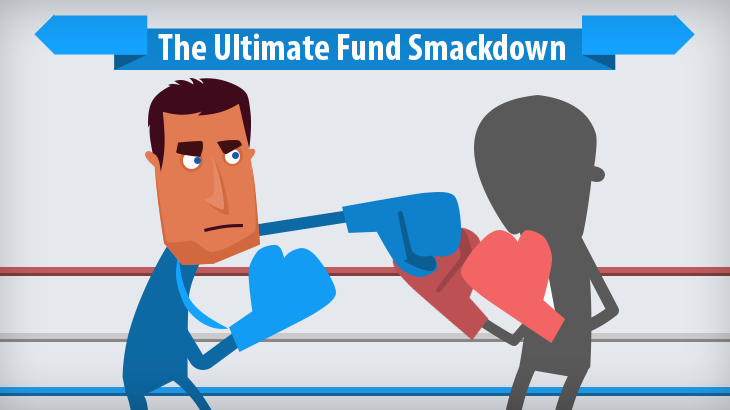There has been plenty of talk about whether actively managed mutual funds are worth the fees they charge. There are many people on either side of the argument. The proponents of active management argue that active managers can add value by selecting the best securities to own or by tactically shifting the asset allocation of the fund. The growing list of opponents argue that net of fees, investors are better off in a low-cost portfolio of ETFs or index funds.
To find the answer, we will put some of the largest and widely held Canadian mutual funds in the ring with a low-cost Modern Potfolio of ETFs and let them battle it out until one wins.
In our last post, the Modern ETF Portfolio easily beat its opponent, the CIBC Monthly Income Fund. For this post, we challenge Investors Canadian Equity Fund (A) from Investors Group to a duel.
Rules of Engagement
For each smackdown, we construct a low-cost, Modern ETF Portfolio that closely matches the historical average asset allocation of the incumbent mutual fund. We put the two investments against each other to see which one reigns supreme. Our assumptions are:
- The initial investment in each portfolio is $25,000
- Trading commissions of $9.95 to buy and sell ETFs, no fees for trading the mutual fund
- Dividends are reinvested at no cost
- The Modern ETF portfolio is rebalanced once per year
We will look at the past performance of the two investment options in terms of their Sharpe Ratio (portfolio returns minus the risk-free rate divided by the standard deviation of returns) over 3, 5, and 10-year periods to determine the winner.
Meet the Players
Modern ETF Portfolio
Investors Canadian Equity Fund
Fund Expenses
0.07%
Fund Expenses
2.58%
Asset Allocation
Asset Allocation
Canadian Equities (XIC)
US Equities (XSP)
Cash
Canadian Equities
US Equities
Cash
Other
Let the Games Begin
First we look at how the two contenders performed in the past:
Modern ETF Portfolio’s past performance is based on a computer-generated back-test using the assumptions outlined below. For ETFs that do not have a long enough history, we use the underlying index’s total return minus the ETF’s annual MER.
$25,000 invested in the Modern ETF portfolio 10 years ago would be worth $51,424 at the end of February 2015, while $25,000 invested in Investors Canadian Equity Fund would be worth only $34,581, a whopping difference of $16,843 or 67% of the original investment!
Below is a summary of annualized risk and return statistics for each of the contenders in the last 3, 5, and 10-year periods:
| Modern ETF Portfolio | vs. | Investors Canadian Equity Fund | ||||||
|---|---|---|---|---|---|---|---|---|
| Risk | Return | Sharpe Ratio | Winner1 | Winner1 | Sharpe Ratio | Return | Risk | |
| 7.90% | 10.93% | 1.24 | Round 1 3-year Performance |
0.88 | 7.96% | 8.03% | ||
| 9.86% | 9.56% | 0.89 | Round 2 5-year Performance |
0.38 | 4.44% | 10.49% | ||
| 13.40% | 7.49% | 0.48 | Round 3 10-year Performance |
0.17 | 3.30% | 14.80% | ||
1The winner of each round is the portfolio with the highest Sharpe Ratio.
The Champion is:

The Modern ETF Portfolio defeated the Investors Canadian Equity Fund by winning all three rounds by a wide margin!
If you are invested in the Investors Canadian Equity Fund, you are risking your financial well-being by paying outrageous fees for an underperforming fund. You might want to switch to a low-cost ETF portfolio and save yourself thousands of dollars in fees and significantly improve your investment returns.
If you need more information on how you can implement a low-cost ETF portfolio, send us an email, and we will be glad to walk you through the steps.
